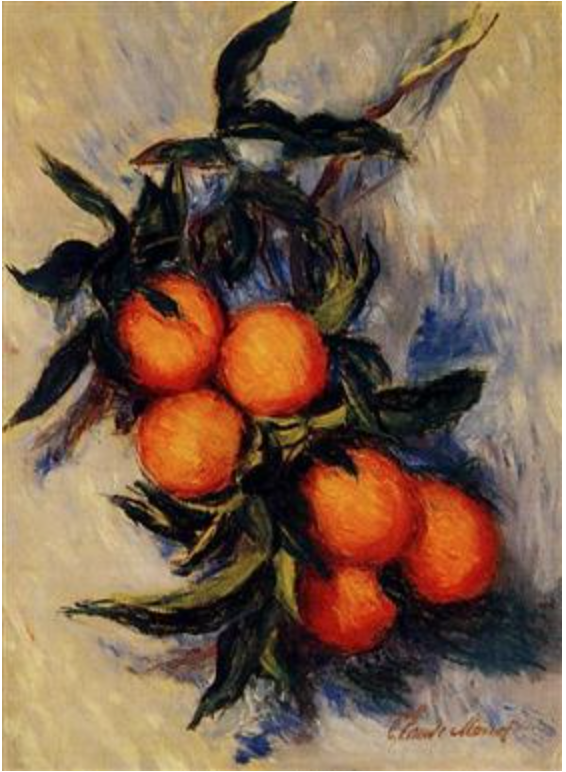Teach This Poem, though developed with a classroom in mind, can be easily adapted for remote-learning, hybrid-learning models, or in-person classes. Please see our suggestions for how to adapt this lesson for remote or blended learning. We have also noted suggestions when applicable and will continue to add to these suggestions online.

Look closely at the image of the painting Branch of Orange Bearing Fruit by Claude Monet.
The following activities and questions are designed to help your students use their noticing skills to move through the poem and develop their thinking about its meaning with confidence, using what they’ve noticed as evidence for their interpretations. Read more about the framework upon which these activities are based.
- Warm-up: (Teachers, before class, ask students to bring in something physical like an object or a photo that represents a memory.) If you feel comfortable, share your object or photo with a partner or small group. Why is this meaningful?
- Before Reading the Poem: Look closely at the image of the painting Branch of Orange Bearing Fruit by Claude Monet. What stands out to you? Why? What does this painting make you think? Why?
- Reading the Poem: Read the poem “Ghazal of Oranges” by Jan-Henry Gray silently. What do you notice about the poem? Annotate for any words or phrases that stand out to you or any questions you might have.
- Listening to the Poem (enlist two volunteers to read the poem aloud): Listen as the poem is read aloud twice, and write down any additional words and phrases that stand out to you. Or, you may opt to listen to the poet read the poem.
- Small-group Discussion: Share what you noticed about the poem with a small group of students. How do the memories shared in the poem connect to the painting and the objects you shared at the beginning of class? What does this poem say about memory?
- Whole-class Discussion: (Teachers, assign students to small groups or partners where they share and discuss one of the couplets.) What do you notice about your assigned couplet? What images or emotions stand out? What does this tell you? What do you notice about the poem’s overall structure? (Teachers, if you haven’t now would be a good time to teach about the ghazal form .) How does the structure of the ghazal impact your reading of the poem?
- Extension for Grades 7-8: Join with a partner or small group. This might be the same small group that you shared with during the discussion. Using your objects from the beginning of class and your own ideas, generate a list of topics that you could write about. As a group choose one topic, and by yourself try writing a couplet. When you are ready, share your couplets. Could these lines work in one poem? How did it feel to write a line? What do you think of your line?
- Extension for Grades 9-12: Read more about the ghazal form. Then, read more ghazals. Choose one to read and discuss with your classmates, or write your own ghazal.
“Take a bite of a fruit or vegetable. Pause long enough to describe its exact colors and textures and smells, its specific taste (and aftertaste). Most likely, this is an item you've eaten before-maybe hundreds of times before--but never stopped to notice. Go through a catalog of your senses, listing every single thing you notice about it, then describe it further through metaphor or story.” Try this writing prompt from Write It! 100 Poetry Prompts to Inspire (Spruce Books, 2020) and browse more poems and activities about food.
